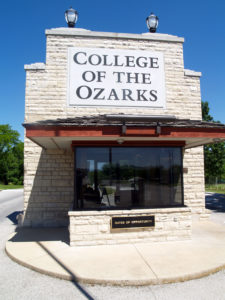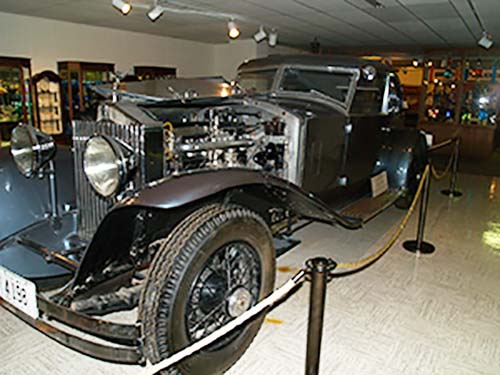Looking for Cheap or Free, Awesome things to do on your Branson, Missouri visit?
Well, here are suggestions for some Free, Cheap, Awesome things to do.
TOP TWO PICKS
In honesty, our two top picks always run neck and neck for first place, so maybe you should visit them both and decide for yourself between the Ralph Foster Museum and Shepherd of the Hills Fish Hatchery.

The Foster Museum is an indoor venue. Its three floors feature an amazing variety of exhibits.
The Hatchery has an indoor visitor’s center with exhibits of area wildlife, plants, and other related topics. You can also watch a movie about the area. The actual hatchery area is outside.
The Foster has a small entrance fee for adults (see below). The Hatchery is free.
So, which one should you visit first? Assuming you have arrived in Branson, one suggestion is heading to one or the other first depending on where in town you are located when you decide you’re ready for a visit.
Naturally, your best bet is to enter your destination into your vehicle or mobile phone GPS. That said, here are wheels on the ground directions from either side of Branson’s most traveled areas.
In or near Historic Downtown Branson? Then, head for the Foster on the Campus of College of the Ozarks.
If you are cruising 76 Country Blvd., around the area of the Titanic across from Walgreens, then, the Hatchery will be a closer drive.
We’ll first cover a visit to the Ralph Foster Museum. Then, in a separate post, the many activiites available at the Hatchery.
We will start this journey at the intersection of Main St. and Bus. 65 in Historic Downtown Branson.
(College of the Ozarks and the Foster Museum can also be reached directly off U.S. Hwy 65 by taking the Hollister exit just south of the Branson exit).
Driving down 76 Country Blvd (east) into old downtown (76 Country Blvd. becomes Main St.) you will reach a traffic light at the intersection mentioned above. On your left, you will spot the Prehistoric Museum. On the right side of the street will be the Branson Hotel. At this intersection you will turn right onto Bus. 65.
(If you miss the turn and drive through the intersection down Main Street and downtown Branson, four short blocks later you can also make a right turn at the Branson Scenic Railroad. Stay on this road over the lower Taneycomo Bridge taking a right off the round-about into Hollister. ( At the roundabout remain vigilant and cautious and yield right of way).
If you are driving out of downtown Branson (west) take a left turn at the intersection traffic light of Main St. and Bus. 65. (P. Graham Dunn on the right side of the intersection, Mr. B’s Ice Cream Parlor on the left}
Continue on Bus. 65 past Branson City Hall (on your right) and the U.S. Post Office (on you left). Drive a short distance to reach the upper bridge over Lake Taneycomo.
Cross the bridge. On the other side of the bridge is a roundabout. KEEP RIGHT FOLLOWING THE SIGN TO HOLLISTER. Remember, as mentioned above, be vigilant, cautious and yield right of way to roundabout traffic. (See post on navigating roundabouts}
Follow Bus. 65 through Hollister. When you see the Casey’s gas station on your left and the Hollister Post Office on your right, you will have approximately one and a half miles to go to the entrance of College of the Ozarks and the Ralph Foster Museum.
POINT OF INTEREST STOP ENROUTE TO THE FOSTER
Hollister’s Historic Downing Street
Take a walk down the City of Hollister’s short main street, Downing Street. If you are observant, you’ll notice Downing St. is under the watchful eye of “Bobby,” a large carving of a British policeman from a bygone era. Historic Downing Street has undergone a rebirth from its early days. The Elizabethan-style historic downtown area shops and restaurant fronts display that theme. Still, Hollister is an all American small town. On the Fourth of July, parked cars lining Bus. 65 and to watch the city’s spectacular fireworks display. In autumn, Hollister closes the street for the Fall Grape Stomp Festival. To get to Downing Street when driving Bus. 65, toward College of the Ozarks, bear right at the small fork in the road just past Casey’s Gas Station on your left and in front of Hook and Ladder Pizza. Parking is free along Downing St.
FOSTER MUSEUM ON THE COLLEGE OF OZARKS CAMPUS
Outside the College of the Ozarks (Hardwork U). campus entrance gate, you will see the Keeter Center on your right. On your left is Patriots Park which contains Vietnam Veterans Memorial and the new Korean War Veterans Memorial (opened and dedicated April 18, 2018). Both memorials were built by college staff and students.
Once through the entrance gate, stay on Opportunity Dr. Follow the maroon paw prints called Bobcat Trail. At Cultural Ct., take a left turn and follow the paw prints to Ralph Foster Museum. There is parking outside the building.
RALPH FOSTER MUSEUM
Open 9:00 a.m. to 4:30 p.m. Monday – Saturday. COST: Adults $6.00, Seniors 62 and older, $5.00. High school age and under, Free. Arrive after 3:00 p.m. next day free with previous day’s receipt.

Pull into the parking lot outside the entrance to the museum and you spot a sign proclaiming – “Ralph Foster Museum: The Smithsonian of the Ozarks.”
You might think, “Wow! That’s quite a proclamation.” Step inside and you’ll quickly understand why the facility is a treasure trove of – well, you name it. The Foster Museum contains exhibits to fascinate any age. The place is educational, awesome, a joy for the curious at heart and most importantly fun.
In sheer square feet, the Foster shrinks in comparison to the Goliath located in Washington, D.C. (325,000 square feet of exhibits), but the Foster’s three stories and 40,000 square feet pack an amazingly diverse collection of exhibits. (The Foster also contains an additional 20,000 sq. ft. of office, research, and storage space).
The Foster is a consistent field trip stop for area schools.
Although the museum is dedicated to “history of the Ozarks region,” many exhibits reach far outside that scope into national and international history.
Exhibit Variety
Listing exhibit titles and their category variety would take too much space. Name a category within reason and you might discover it at the Foster – large to tiny, wood to steel, architecture to machinery, mineral to plant , wildlife to natural history. There are exhibits featuring china, clothing, autos, firearms, fishing lures, people and places. This only scratches the surface. The list goes on.
As one visitor was overheard saying, “It has got everything you want to see. I’ve been there twice!”

The museum has a staff continuing the Foster’s long tradition of collecting, preserving, interpreting, and exhibiting items relating to the Ozarks region. The institute’s tradition has continued some eight decades.
Spend one hour, an afternoon, or all day at the Foster. It might plant the seeds for a new interest dropping into your life. Chances are, if you plan to visit an hour, you will wind-up staying longer, and as previously noted, arrive after 3:00 p.m., and your admission receipt can be used for entrance the following day.
Undoubtedly, you will learn something new that just might plant the seeds for a new interest or hobby in your life.
BRIEF FOSTER MUSEUM HISTORY
Ralph Foster Museum’s history goes back to the 1920’s. Its namesake stems from Ralph Foster an early radio pioneer of the 1920’s He and a partner Jerry Hall, started a radio station as a hobby in the corner of a St. Joseph, Mo., tire store. In 1930’s they moved the station to Springfield, Mo.
School of the Ozarks (now College of the Ozarks) President Dr. Robert Good started which would become the museum in a dormitory basement with exhibits of butterflies, birds. In the 1960’s, the fledgling museum attracted the attention of Foster. He donated his Western and Native American artifact collection. Foster’s monetary donations, helped build a new wing. Further expansions followed.
In the 1960s Forster donated an extensive Western Native American Those artifact collection to the museum. Through the years, his interest in contributions remain consistent. In 1969 is financial contributions made a new wing and entrance possible.
Whoa! Lots more to see on your visit to… College of the Ozarks.
Stroll around Lake honor on the campus of College of the Ozarks and begin to feel the quiet serenity and tradition that is the school.
The thousand- acre campus at Pt. Lookout overlooking Lake Taneycomo, has been recognized in national publications for a variety of qualities. US News and World report has categorized it as “Best College” each year since 1989.
Perhaps one of its most unique and charished educational contributions is the tuition structure. Full-time students work at one of 80 campus jobs or industries to pay for the education — hence the college’s moniker Hardwork U. The remainder student tuition cost is provided by scholarships, gifts and contributions. Students graduate debt-free after earning a Bachelor of Arts or Bachelor of Science degree.
Pick up a campus map that outlines self-guided tours of the campus at the Keeter Center (just outside the entrance to the campus)
https://www.rfostermuseum.com/Page/Visit.672.html
OTHER CAMPUS SPOTS
Other popular places of interest include greenhouses, Edwards Mill powered by a 12- foot water wheel where students grind whole grain flour and meal, a tractor museum, the Williams Chapel where Sunday services are held.
Keeter Center has a lodge, gift shop, restaurant. Inside the center is the Vietnam Gallery Exhibit. It contains, exhibits, documents, military vehicle, maps and more. The exhibit is very comprehensive for its size and also includes Korean War exhibits.
College of the Ozarks history and tradition is long and colorful, its graduates distinguished. Interested in reading more about the school? Ask where books written about the college that can be purchased on campus.
Ask about the college’s Fruit Cake and Jelly Kitchen. Confections all expertly made by students. The kitchen bakes some 25,000 fruitcakes a year. Open 8 a.m. until 5:00 p.m.
-
CHECK POST ON OUR OTHER PICKS FOR FREE OR CHEAP FUN ACTIVITIES PLUS MORE.
- In blogs to follow we will suggest others. We will also be posting other good-to-know Visitor Hacks on a variety of subjects we hope will be informative to Branson visitors. What do we know about this Tri-Lakes area and how do we know it? After moving to Branson with our kids a couple decades ago, we’ve been around the block a couple times in these parts. As writers and photographers, we’ve covered Branson and the surrounding area for a variety of publications. Over time, we’ve gotten to know the community, people, places and things. Our ideas are not just suggestions for Branson area visitors with families, but for anyone visiting the Branson area. These visitor hacks are subjective and unsolicited. We hope they will make your visit even more enjoyable.
— All photos by BransonMoVisitorHacks–